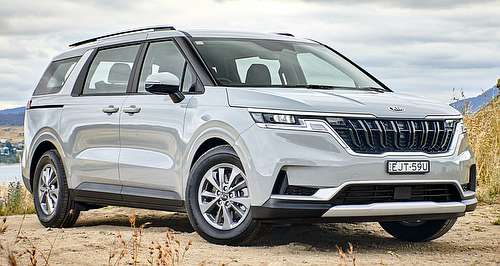Counting seats: New surprises in the once bland people-mover market are giving attention to players such as Kia’s Carnival and now Hyundai’s space-age Staria.
Gallery

Click to see larger images
THE arrival of the refreshingly chamfer-block shaped Hyundai Staria puts more emphasis on people movers as potential rivals for the dominant SUV genre and could even take on utes as a dual-purpose family-work vehicle.
People movers, once banished to the end of the new-car shopping list because of the often derogatory “big-family” label, have really come into their own due to greater affordability, car-like levels of safety and technology, and more importantly, higher appeal thanks to some very fresh designs.
There have been historic touchpoints where people movers drifted in and out of favour, mainly attributed to new designs for rising interest and then waning sales caused by factors including the arrival of fashionable SUV rivals and in some cases, some poor safety reviews.
People movers were traditionally commercial vans with extra seats and windows. Most, on reflection, lacked everything that a family needed most, except for space.
Early-day Nissan/Ford/Mazda vans had cart-sprung rear ends that gave a high payload rating but for human cargo, the result was a choppy ride and suspect handling, while durable cabin trim lacked any semblance of quality and did little to reduce interior noise levels.
When the Toyota Tarago moved from a commercial-looking van – even though it never was – to its late 1980s “egg” shape, buyers paid attention and when Honda introduced its Odyssey, it showed manufacturers were aware that buyers wanted a bit of glam with the space.
By 2009, the commercial vans had all but disappeared and parents – and their children – moved into a more comfortable age.
They also had more choice. In 2009 there were 18 models to choose from and most, unregrettably, have also disappeared. These include the Chrysler Voyager, Dodge Journey, Kia Rondo, Mitsubishi Grandis, Renault Scenic, SsangYong Stavic and Toyota Avensis.
By 2014 there were offerings such as the sophisticated Citroen C4 Grand Picasso that, despite its clever features, was generally overlooked as buyers went more mainstream and pushed the Honda Odyssey to the top of the sector’s ladder with 2552 sales or 26.6 per cent people mover market share.
That year, the Odyssey outsold the once top-selling Kia Carnival that a year earlier sold 2847 units for 33.5 per cent of the market.
But the Carnival reclaimed its top position the year later and by 2016 had almost 40 per cent of people mover buyers driving them out of Kia showrooms. It was to stay this way for the next four years and even today, the latest iteration of the Carnival holds more than 60 per cent of segment sales.
Hyundais’ Staria, with components shared with the Carnival, may push the siblings’ people mover share higher. Currently, the outgoing Hyundai multi-seater, the iMax, has virtually sold all units left in stock and the Staria nameplate is starting from scratch.
In 2015, the iMax was selling an average of close to 170 units a month. The success of Staria – which sells from $48,500 before on-road costs, $3570 more than its predecessor but carrying a great deal more standard technology – could repeat the 2015 figures.
The missing model in all this is the Tarago that has been replaced by the HiAce-based Granvia. It is not because Toyota has left the category, but because the Granvia is more expensive than most rivals.
At $64,090 (plus on-road costs) entry point and a $75,603 (plus costs) end point, it is now out of reach for average-income large families.
The Granvia sells about 20 units a month – a far cry from the 110 a month achieved by the Tarago in 2010 and out of touch with the 402 Carnivals that Kia delivered in July this year alone.













Facebook Twitter Instagram